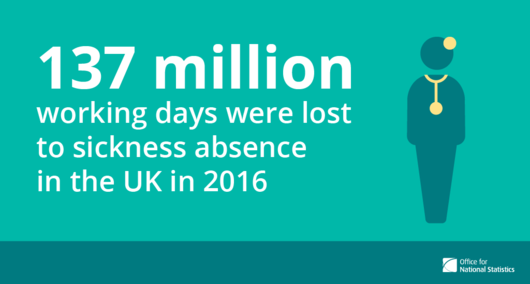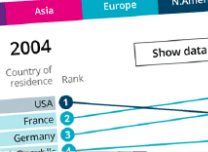Employment and labour market Sickness absence in the labour market: Mar 2017 137.3 million working days were lost due to sickness or injury in the UK in 2016, equivalent to 4.3 days per worker. This is the lowest recorded since the series began in 1993, when it was 7.2 days per worker. Since 2003, there has been a general decline in the number of days lost to sickness absence, particularly during the economic downturn, although there were increases in 2014 and 2015.  Minor illnesses such as coughs and colds were the most common cause of absence in 2016, making up 24.8% of the total days lost. This was followed by musculoskeletal problems (including back pain, neck and upper limb problems), making up 22.4%. After 'other' conditions, mental health issues (including stress, depression, anxiety and serious conditions) were the next most common reason for sickness absence, resulting in 15.8 million days lost (11.5%). Find out more about sickness absence in the labour market in our latest release. People, population and community Measuring national well-being in the UK: international comparisons, 2017 In 2015, 16% of UK households reported either difficulty or great difficulty in making ends meet, lower than the EU average of 26%. People in Greece (78%) were most likely to report difficulty while people in Sweden (5%) were least likely. 59% of people in the UK agreed or agreed strongly that they felt close to other people in the area where they lived, slightly higher than Germany (58%), the lowest-ranking country in 2012. The highest-ranked country was Cyprus (81%). Explore more on how the UK compares internationally across various wellbeing measures. Early indicator estimates from the Wealth and Assets Survey: attitudes towards saving for retirement, credit commitments and debt burden, July 2014 to June 2016
In the period July 2014 to June 2016, of all adults questioned, 40% believed employer pension schemes were the safest way to save for retirement, broadly similar to 2012 to 2014 (39%), though an increase on 2010 to 2012 (35%).
46% considered that property would make the most of their money in 2014 to 2016, an increase on 2012 to 2014 when this figure was 43%.
Almost a third (32%) of those who expected occupational or personal pensions to provide income in retirement were not currently contributing to a pension with almost half of them (46%) reporting "low income, not being in work or still in education" as the reason. Did you see our Spring Budget tweetalong yesterday? Catch up with what ONS and our team of statisticians shared on Twitter alongside #Budget2017. | 










No comments:
Post a Comment